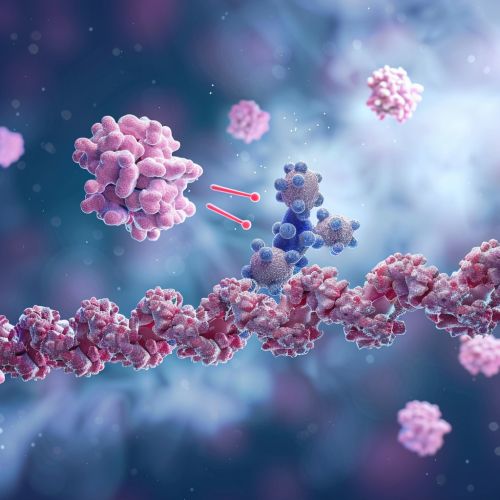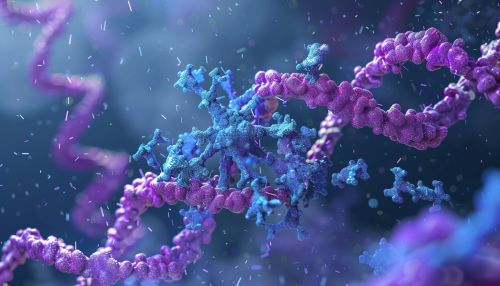Enzyme inhibitor: Difference between revisions
(Created page with "== Enzyme Inhibitor == An enzyme inhibitor is a molecule that binds to an enzyme and decreases its activity. Since enzymes catalyze nearly all of the chemical reactions in biological systems, enzyme inhibitors are a crucial area of study in biochemistry and pharmacology. They are used in medicine to treat various diseases, in agriculture to control pests, and in research to study enzyme function and metabolic pathways. == Types of Enzyme Inhibitors == Enzyme inhibitor...") |
No edit summary |
||
| Line 15: | Line 15: | ||
Competitive inhibitors bind to the active site of the enzyme, competing directly with the substrate. This type of inhibition can be overcome by increasing the concentration of the substrate. An example of a competitive inhibitor is methotrexate, which inhibits the enzyme dihydrofolate reductase. | Competitive inhibitors bind to the active site of the enzyme, competing directly with the substrate. This type of inhibition can be overcome by increasing the concentration of the substrate. An example of a competitive inhibitor is methotrexate, which inhibits the enzyme dihydrofolate reductase. | ||
[[Image:Detail-92473.jpg|thumb|center|Illustration of a competitive inhibitor binding to the active site of an enzyme, preventing the substrate from binding.|class=only_on_mobile]] | |||
[[Image:Detail-92474.jpg|thumb|center|Illustration of a competitive inhibitor binding to the active site of an enzyme, preventing the substrate from binding.|class=only_on_desktop]] | |||
==== Non-Competitive Inhibitors ==== | ==== Non-Competitive Inhibitors ==== | ||
Latest revision as of 10:21, 14 June 2024
Enzyme Inhibitor
An enzyme inhibitor is a molecule that binds to an enzyme and decreases its activity. Since enzymes catalyze nearly all of the chemical reactions in biological systems, enzyme inhibitors are a crucial area of study in biochemistry and pharmacology. They are used in medicine to treat various diseases, in agriculture to control pests, and in research to study enzyme function and metabolic pathways.
Types of Enzyme Inhibitors
Enzyme inhibitors can be classified based on their mechanism of action and the nature of their interaction with the enzyme. The two main types are reversible and irreversible inhibitors.
Reversible Inhibitors
Reversible inhibitors bind to enzymes through non-covalent interactions such as hydrogen bonds, ionic bonds, and hydrophobic interactions. These inhibitors can be further divided into competitive, non-competitive, uncompetitive, and mixed inhibitors.
Competitive Inhibitors
Competitive inhibitors bind to the active site of the enzyme, competing directly with the substrate. This type of inhibition can be overcome by increasing the concentration of the substrate. An example of a competitive inhibitor is methotrexate, which inhibits the enzyme dihydrofolate reductase.


Non-Competitive Inhibitors
Non-competitive inhibitors bind to an allosteric site, a site other than the active site, causing a conformational change in the enzyme that reduces its activity. This type of inhibition cannot be overcome by increasing substrate concentration. An example is the inhibition of cytochrome c oxidase by cyanide.
Uncompetitive Inhibitors
Uncompetitive inhibitors bind only to the enzyme-substrate complex, preventing the complex from releasing products. This type of inhibition decreases both the apparent Km and Vmax of the enzyme. Lithium is an example of an uncompetitive inhibitor that affects inositol monophosphatase.
Mixed Inhibitors
Mixed inhibitors can bind to both the enzyme alone and the enzyme-substrate complex, but with different affinities. This results in a decrease in Vmax and a change in Km, depending on the relative affinities. An example is the inhibition of alkaline phosphatase by phosphate ions.
Irreversible Inhibitors
Irreversible inhibitors form covalent bonds with the enzyme, leading to permanent inactivation. These inhibitors are often used as drugs or poisons. Examples include aspirin, which irreversibly inhibits cyclooxygenase, and penicillin, which inhibits transpeptidase.
Mechanisms of Inhibition
The mechanisms by which enzyme inhibitors function are diverse and can be complex. Understanding these mechanisms is crucial for the development of new drugs and therapies.
Active Site Inhibition
Inhibitors that target the active site of an enzyme typically mimic the substrate's structure. This allows them to bind effectively and block substrate access. This mechanism is common in competitive inhibitors.
Allosteric Inhibition
Allosteric inhibitors bind to sites other than the active site, inducing conformational changes that reduce enzyme activity. This mechanism is seen in non-competitive and some mixed inhibitors.
Covalent Modification
Irreversible inhibitors often work by covalently modifying specific amino acid residues in the enzyme's active site. This modification permanently inactivates the enzyme. Examples include the alkylation of cysteine residues by iodoacetamide.
Applications of Enzyme Inhibitors
Enzyme inhibitors have a wide range of applications in medicine, agriculture, and research.
Medical Applications
In medicine, enzyme inhibitors are used to treat various diseases by targeting specific enzymes involved in disease pathways.
Antibacterial Agents
Many antibiotics function as enzyme inhibitors. For example, β-lactam antibiotics like penicillin inhibit bacterial cell wall synthesis by targeting transpeptidase enzymes.
Antiviral Agents
Enzyme inhibitors are also used to treat viral infections. Protease inhibitors, such as those used in HIV therapy, inhibit viral proteases essential for viral replication.
Cancer Therapy
Certain enzyme inhibitors are used in cancer treatment. Tyrosine kinase inhibitors, such as imatinib, target specific kinases involved in cancer cell proliferation.
Agricultural Applications
In agriculture, enzyme inhibitors are used as pesticides and herbicides. For example, organophosphates inhibit acetylcholinesterase, an enzyme essential for nerve function in insects.
Research Applications
Enzyme inhibitors are valuable tools in biochemical research. They are used to study enzyme kinetics, metabolic pathways, and the regulation of enzyme activity.
Challenges and Considerations
The development and use of enzyme inhibitors come with several challenges and considerations.
Selectivity
Achieving selectivity is crucial to minimize off-target effects and toxicity. Researchers aim to design inhibitors that specifically target the desired enzyme without affecting other enzymes.
Resistance
Resistance to enzyme inhibitors can develop, particularly in the context of antibiotics and cancer therapy. This necessitates the continuous development of new inhibitors.
Pharmacokinetics
The pharmacokinetic properties of enzyme inhibitors, including absorption, distribution, metabolism, and excretion, are critical for their efficacy and safety. These properties must be carefully optimized during drug development.
Future Directions
The field of enzyme inhibition is continually evolving, with ongoing research aimed at discovering new inhibitors and improving existing ones.
Structure-Based Drug Design
Advances in structural biology and computational chemistry are enabling structure-based drug design, allowing for the rational design of inhibitors based on the three-dimensional structure of target enzymes.
Allosteric Modulators
The discovery of allosteric modulators, which can fine-tune enzyme activity rather than completely inhibit it, represents a promising area of research. These modulators offer the potential for more precise therapeutic interventions.
Combination Therapies
Combining enzyme inhibitors with other therapeutic agents is an emerging strategy to enhance efficacy and reduce resistance. This approach is being explored in cancer and infectious disease treatments.
